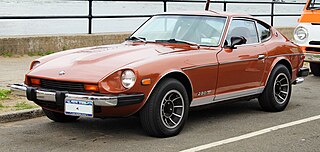
The Nissan Z-series is a model series of sports cars manufactured by Nissan since 1969.

A kit car is an automobile available as a set of parts that a manufacturer sells and the buyer then assembles into a functioning car. Usually, many of the major mechanical systems such as the engine and transmission are sourced from donor vehicles or purchased new from other vendors. Kits vary in completeness, consisting of as little as a book of plans, or as much as a complete set with all components to assemble into a fully operational vehicle such as those from Caterham.

A sports car is a car designed with an emphasis on dynamic performance, such as handling, acceleration, top speed, the thrill of driving, and racing capability. Sports cars originated in Europe in early 1902 and are currently produced by many manufacturers around the world.

The Mitsubishi 3000GT is a front-engine, all-wheel/front-wheel drive grand touring/sports car manufactured and marketed by Mitsubishi from 1990 until 2000 over three different generations. Manufactured in a three-door hatchback coupé body style in Nagoya, Japan, the 2+2 four-seaters were marketed in the Japanese domestic market (JDM) as the GTO, and globally as 3000GT. In North America, it was sold both as the Mitsubishi 3000GT (1991–1999) and the Dodge Stealth (1991–1996), a badge engineered, mechanically identical captive import. As a collaborative effort between Chrysler and Mitsubishi Motors, Chrysler was responsible for the Stealth's exterior styling.

The Ferrari 250 GTO is a grand tourer produced by Ferrari from 1962 to 1964 for homologation into the FIA's Group 3 Grand Touring Car category. It was powered by Ferrari's Tipo 168/62 Colombo V12 engine.
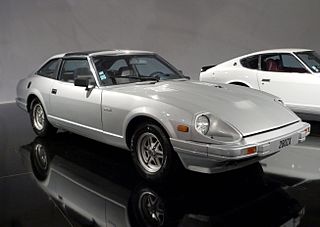
The Nissan S130 is a sports coupé produced by Nissan in Japan from 1978 until 1983. It was sold as the Datsun 280ZX, Nissan Fairlady Z and Nissan Fairlady 280Z, depending on the market. In Japan, it was exclusive to Nissan Bluebird Store locations. It was the second generation Z-car, replacing the Nissan Fairlady Z (S30) in late 1978. The 280ZX was the first time the "by Nissan" subscript was badged alongside the Datsun logo, along with Nissan trucks. The 280ZX was Motor Trend's import car of the year for 1979. The 280ZX was replaced by the Nissan 300ZX in 1984.

The Nissan S30, sold in Japan as the Nissan Fairlady Z and in other markets as the Datsun 240Z, then later as the 260Z and 280Z, is a grand tourer produced by Nissan from 1969 until 1978. The S30 was conceived of by Yutaka Katayama, the President of Nissan Motor Corporation U.S.A., and designed by a team led by Yoshihiko Matsuo, the head of Nissan's Sports Car Styling Studio. It is the first car in Nissan's Z series of sports cars.

Carrozzeria Scaglietti was an Italian automobile design and coachbuilding company active in the 1950s. It was founded by Sergio Scaglietti in 1951 as an automobile repair concern, but was located across the road from Ferrari in Maranello outside Modena, Italy.

The Ferrari 250 is a series of sports cars and grand tourers built by Ferrari from 1952 to 1964. The company's most successful early line, the 250 series includes many variants designed for road use or sports car racing. 250 series cars are characterized by their use of a 3.0 L (2,953 cc) Colombo V12 engine designed by Gioacchino Colombo. They were replaced by the 275 and 330 series cars.
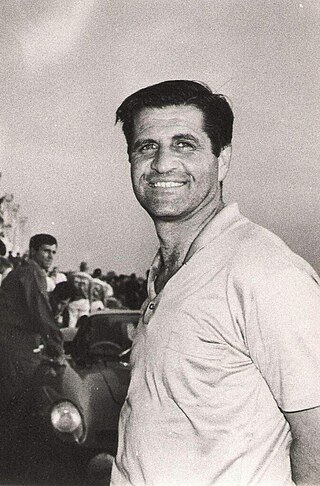
Giotto Bizzarrini was an Italian automobile engineer who was active from the 1950s through the 1970s.

The Ferrari 250 GT SWB Breadvan is a one-off Ferrari made in 1962 from a 1961 Ferrari 250 GT Berlinetta SWB, chassis number 2819 GT. It was built to compete against the new 1962 Ferrari 250 GTO at the 24 Hours of Le Mans and other FIA World Sportscar Championship races.

Christopher Forsberg, is an American Formula D driver from Doylestown, Pennsylvania. He currently competes in the Formula Drift series in his Nissan Z (Z34) for NOS Energy Drink, and is the owner, driver and shop manager of Forsberg Racing.

The Ferrari Monza is one of a series of cars built by Ferrari. In the early 1950s, Ferrari shifted from using the compact Gioacchino Colombo-designed V12 engine in its smallest class of sports racers to a line of four-cylinder engines designed by Aurelio Lampredi. Inspired by the success of the light and reliable 2.5 L 553 F1 car, the four-cylinder sports racers competed successfully through the late 1950s, culminating with the famed 500 Mondial and 750 Monza.

McBurnie Coachcraft was a US bodywork company mostly known for their replicas of Ferrari Daytona Spyder. McBurnie also manufactured a Ferrari 250 GTO replica in the style of the Alpha One GTO, and the Velo Rossa. See, Ferrari S.p.A. v. McBurnie Coachcraft, 10 U.S.P. Q.2d 1278 (S.D.Cal.1988).
The cars in Miami Vice mainly involve the Ferrari Daytona Spyder and the Ferrari Testarossa, but also include other automobiles driven by the characters on the show. Currently one Daytona is in a private collection and the other is on display at the Volo Auto Museum; the Ferrari Testarossa stunt car resides in Kingsport, Tennessee and is owned by Carl Roberts of Carl Roberts Motor Group. Today, one of the hero cars is part of The Witvoet collection owned by Bastiaan Witvoet in Belgium.
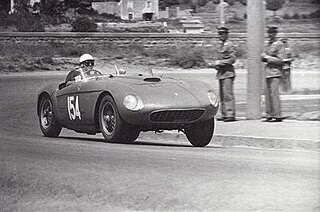
The Ferrari 250 Monza was a sports racing car produced by Ferrari in 1954. It was a combination of a stretched chassis and body from the line of inline-four-engined racers with an ubiquitous 3.0-litre Colombo V12 engine.
Neri and Bonacini, also known as Nembo, was a small carrozzeria and mechanic shop based in Modena, Italy, active from the late 1950s to around 1967. Founded and run by Giorgio Neri and Luciano Bonacini, the shop worked on and produced bodies for Ferrari, Lamborghini and Maserati road and race cars, both in an official capacity for those manufacturers and for private owners. Their best known projects are the Ferrari 250 GT-based Nembo spiders and the Lamborghini 400GT Monza. Neri and Bonacini also designed a car under their own name, the Neri and Bonacini Studio GT Due Litri. Two prototypes of this car were made between 1966 and 1968 but it never entered series production. The shop closed around 1967 when Bonacini went to work for De Tomaso and Neri started his own shop, Motors-World-Machines (MWM).
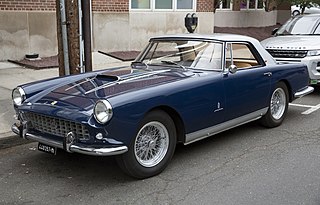
The Ferrari 250 GT Coupé represented a series of road-going, grand touring cars produced by Ferrari between 1954 and 1960. Presented at the 1954 Paris Motor Show, the 250 Europa GT was the first in the GT-lineage. The design by Pinin Farina was seen as a more civilised version of their sporty Berlinetta 250 MM. Series built cars were an answer to the wealthy clientele demands of a sporty and luxurious Ferrari Gran Turismo, that is also easier to use daily.
Thomas Meade was an American automobile designer and dealer best known for his Thomassima series of custom cars based on Ferrari engines and chassis. He was based in Modena, Italy from the early 1960s through the early 1970s, where he met and collaborated with many Modenese carrozzerie, manufacturers and mechanics.

















